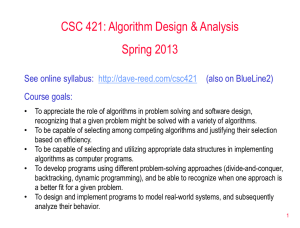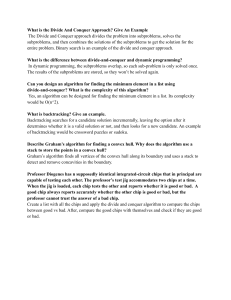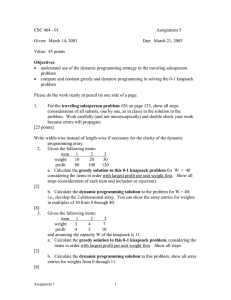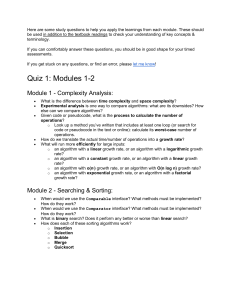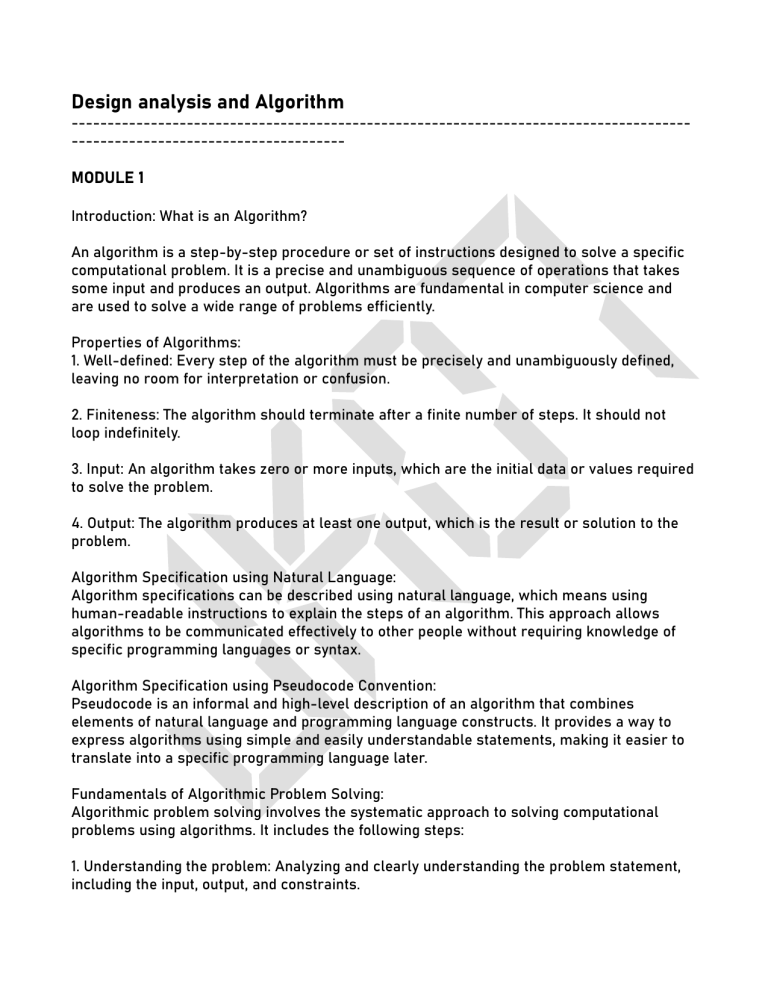
Design analysis and Algorithm --------------------------------------------------------------------------------------------------------------------------- MODULE 1 Introduction: What is an Algorithm? An algorithm is a step-by-step procedure or set of instructions designed to solve a specific computational problem. It is a precise and unambiguous sequence of operations that takes some input and produces an output. Algorithms are fundamental in computer science and are used to solve a wide range of problems efficiently. Properties of Algorithms: 1. Well-defined: Every step of the algorithm must be precisely and unambiguously defined, leaving no room for interpretation or confusion. 2. Finiteness: The algorithm should terminate after a finite number of steps. It should not loop indefinitely. 3. Input: An algorithm takes zero or more inputs, which are the initial data or values required to solve the problem. 4. Output: The algorithm produces at least one output, which is the result or solution to the problem. Algorithm Specification using Natural Language: Algorithm specifications can be described using natural language, which means using human-readable instructions to explain the steps of an algorithm. This approach allows algorithms to be communicated effectively to other people without requiring knowledge of specific programming languages or syntax. Algorithm Specification using Pseudocode Convention: Pseudocode is an informal and high-level description of an algorithm that combines elements of natural language and programming language constructs. It provides a way to express algorithms using simple and easily understandable statements, making it easier to translate into a specific programming language later. Fundamentals of Algorithmic Problem Solving: Algorithmic problem solving involves the systematic approach to solving computational problems using algorithms. It includes the following steps: 1. Understanding the problem: Analyzing and clearly understanding the problem statement, including the input, output, and constraints. 2. Designing an algorithm: Devising a step-by-step plan or strategy to solve the problem, considering appropriate data structures and algorithmic techniques. 3. Implementing the algorithm: Translating the algorithm into a specific programming language to create a working program. 4. Testing and debugging: Evaluating the program's correctness and efficiency through testing and fixing any issues or errors. 5. Analyzing the algorithm: Assessing the efficiency and performance of the algorithm in terms of time complexity and space complexity. Analysis Framework: Time Efficiency and Space Efficiency: Time efficiency refers to the amount of time an algorithm takes to run or execute, usually measured in terms of the number of operations or comparisons performed. Space efficiency, on the other hand, refers to the amount of memory or storage space required by an algorithm. Worst-case, Best-case, and Average-case Efficiency: - Worst-case efficiency represents the maximum time or space required by an algorithm to solve a problem for any given input size. - Best-case efficiency represents the minimum time or space required by an algorithm to solve a problem for any given input size. - Average-case efficiency represents the expected time or space required by an algorithm to solve a problem, considering all possible inputs and their probabilities of occurrence. Performance Analysis: Estimating Space Complexity and Time Complexity of Algorithms: Space complexity refers to the amount of memory or storage space required by an algorithm to solve a problem. It is typically measured in terms of the size of the input and additional space used by the algorithm. Time complexity measures the running time of an algorithm as a function of the input size. It allows us to estimate how the algorithm's execution time grows as the input size increases. Asymptotic Notations: Big-O Notation (O), Omega Notation (Ω), Theta Notation (Θ): Asymptotic notations are used to describe the behavior of an algorithm's time complexity or space complexity as the input size approaches infinity. - Big-O notation (O): It represents the upper bound of an algorithm's growth rate, indicating the worst-case time or space complexity. - Omega notation (Ω): It represents the lower bound of an algorithm's growth rate, indicating the best-case time or space complexity. - Theta notation (Θ): It represents the tight bound of an algorithm's growth rate, indicating both the upper and lower bounds, implying the average-case time or space complexity. Basic Efficiency Classes: Basic efficiency classes categorize algorithms based on their growth rates or complexities. Some common classes include constant time (O(1)), logarithmic time (O(log n)), linear time (O(n)), quadratic time (O(n^2)), and exponential time (O(2^n)). Mathematical Analysis of Non-Recursive and Recursive Algorithms with Examples: Non-recursive algorithms are those that do not use recursive function calls, while recursive algorithms involve calling the same function within itself. Mathematical analysis of algorithms involves expressing their time complexity or space complexity using mathematical equations or formulas. This analysis helps in understanding the algorithm's efficiency and predicting its performance for different input sizes. Examples of Brute Force Design Technique: 1. Selection sort: A simple sorting algorithm that repeatedly selects the smallest element from an unsorted portion of the list and places it at the beginning. The complexity of the selection sort algorithm is O(n^2). 2. Sequential search: A basic searching algorithm that sequentially checks each element in a list until a match is found or the end of the list is reached. The worst-case complexity of sequential search is O(n). 3. String matching algorithm: A technique to find the occurrence or position of a pattern within a text. Brute-force string matching compares the pattern with each possible position in the text. The complexity of this algorithm is O(m * n), where m is the length of the pattern and n is the length of the text. By understanding and applying these concepts, engineers can assess the efficiency and performance of algorithms, choose appropriate design techniques, and solve engineering problems effectively. --------------------------------------------------------------------------------------------------------------------------- MODULE 2 Divide and Conquer: The divide and conquer technique is a problem-solving approach that involves breaking down a complex problem into smaller subproblems, solving each subproblem independently, and then combining the solutions to obtain the final solution. The general method of the divide and conquer technique can be summarized as follows: 1. Divide: Break the problem into smaller subproblems that are similar to the original problem but of reduced size. 2. Conquer: Solve the subproblems recursively. If the subproblems are small enough, solve them directly using a base case. 3. Combine: Combine the solutions of the subproblems to obtain the final solution to the original problem. Recurrence Equation for Divide and Conquer: A recurrence equation describes the time complexity of a divide and conquer algorithm by expressing the running time of a problem in terms of the running time of its subproblems. It defines the relationship between the input size and the time complexity. Solving Recurrence Equations using Master's Theorem: The Master's theorem is a technique for solving recurrence equations that arise in the analysis of divide and conquer algorithms. It provides a framework to determine the time complexity of an algorithm based on the form of the recurrence equation. The Master's theorem is typically applicable to recurrence equations that can be expressed in the form: T(n) = a * T(n/b) + f(n), where T(n) represents the running time of the algorithm for an input size of n, a represents the number of subproblems, n/b represents the size of each subproblem, and f(n) represents the time complexity of the divide and combine steps. Divide and Conquer Algorithms and Complexity Analysis: 1. Finding the maximum and minimum: The divide and conquer approach can be used to find the maximum and minimum elements in an array. The array is divided into smaller subarrays, and the maximum and minimum of each subarray are compared and combined to obtain the overall maximum and minimum. The time complexity of this algorithm is O(n), where n is the size of the array. 2. Binary search: Binary search is a divide and conquer algorithm used to search for a target element in a sorted array. It repeatedly divides the array into halves and narrows down the search range until the target element is found or the search range is empty. The time complexity of binary search is O(log n), where n is the size of the array. 3. Merge sort: Merge sort is a sorting algorithm that follows the divide and conquer strategy. It recursively divides the array into halves, sorts the individual halves, and then merges them to obtain a sorted array. The time complexity of merge sort is O(n log n), where n is the size of the array. 4. Quick sort: Quick sort is another sorting algorithm that uses the divide and conquer technique. It partitions the array based on a pivot element, recursively sorts the partitions, and combines them to obtain a sorted array. The time complexity of quick sort is O(n log n) on average, but it can be O(n^2) in the worst case. Decrease and Conquer Approach: The decrease and conquer approach is a problem-solving technique where the problem is reduced to a smaller instance of the same problem and solved recursively. It differs from divide and conquer in that it doesn't divide the problem into multiple subproblems but focuses on reducing the problem size until a base case is reached. Introduction to Decrease and Conquer Approach: The decrease and conquer approach involves the following steps: 1. Decrease: Reduce the problem to a smaller instance or a simpler version of the same problem. 2. Conquer: Solve the reduced problem recursively. If the problem is small enough, solve it directly using a base case. Efficiency Analysis: The efficiency analysis of decrease and conquer algorithms is typically done by considering the time complexity or space complexity of the algorithm. The time complexity is often expressed in terms of the input size. Examples of Decrease and Conquer Algorithms: 1. Insertion sort: Insertion sort is a simple sorting algorithm that iteratively builds the final sorted array by inserting each element into its correct position. It reduces the problem of sorting an array to the problem of inserting an element into a sorted subarray. The time complexity of insertion sort is O(n^2), where n is the size of the array. 2. Graph searching algorithms: Decrease and conquer can be applied to graph searching algorithms such as depth-first search (DFS) and breadth-first search (BFS). These algorithms reduce the problem of searching a graph to the problem of searching its adjacent vertices. The time complexity of DFS and BFS is O(V + E), where V is the number of vertices and E is the number of edges in the graph. 3. Topological sorting: Topological sorting is a technique used to order the vertices of a directed acyclic graph (DAG) based on their dependencies. It reduces the problem of topological sorting to the problem of finding a vertex with no incoming edges and removing it from the graph. The time complexity of topological sorting is O(V + E), where V is the number of vertices and E is the number of edges in the graph. By understanding and applying these concepts, engineers can effectively analyze and solve problems using divide and conquer and decrease and conquer techniques, and select appropriate algorithms for different scenarios. --------------------------------------------------------------------------------------------------------------------------- MODULE 3 Greedy Method: The greedy method is a problem-solving approach that involves making locally optimal choices at each step with the hope of finding a globally optimal solution. It follows a general method that can be summarized as follows: 1. Initialization: Initialize the solution to an empty or trivial solution. 2. Greedy Choice: Make a locally optimal choice that seems best at the current step, without considering the future consequences. 3. Feasibility Check: Check if the chosen solution is feasible or satisfies the problem constraints. 4. Update Solution: Update the current solution by including the chosen element or making the necessary adjustments. 5. Termination Condition: Check if the solution is complete or if the termination condition is met. If not, go back to step 2. Greedy Method Examples: 1. Coin Change Problem: The coin change problem involves finding the minimum number of coins needed to make a given amount of change. The greedy approach for this problem is to always choose the largest coin denomination that is smaller than the remaining change. This strategy ensures that the total number of coins used is minimized. 2. Knapsack Problem: The knapsack problem involves choosing a subset of items with maximum value to fit into a knapsack with a limited capacity. The greedy approach for the fractional knapsack problem is to select items based on their value-to-weight ratio, picking the items with the highest ratio first until the knapsack is full. However, the same approach does not work for the 0/1 knapsack problem. 3. Job Sequencing with Deadlines Problem: In this problem, there are multiple jobs with associated profits and deadlines. The goal is to schedule the jobs in a way that maximizes the total profit. The greedy approach involves sorting the jobs in decreasing order of profit and assigning each job to the latest possible deadline that is not already filled. Minimum Cost Spanning Trees: 1. Prim's Algorithm: Prim's algorithm is a greedy algorithm used to find the minimum cost spanning tree of a connected, weighted graph. It starts with an arbitrary vertex and adds the edge with the minimum weight that connects a visited vertex to an unvisited vertex. This process is repeated until all vertices are visited, forming the minimum cost spanning tree. 2. Kruskal's Algorithm: Kruskal's algorithm is another greedy algorithm for finding the minimum cost spanning tree. It starts with an empty graph and iteratively adds the edges with the minimum weight, while ensuring that no cycles are formed. The algorithm stops when all vertices are included or when the desired number of edges is reached. Single Source Shortest Paths: Dijkstra's Algorithm: Dijkstra's algorithm is a greedy algorithm used to find the shortest paths from a single source vertex to all other vertices in a weighted graph. It maintains a priority queue to keep track of the tentative distances from the source vertex to all other vertices. The algorithm selects the vertex with the minimum distance at each step and updates the distances of its neighboring vertices. This process continues until all vertices have been processed. Optimal Tree Problem: Huffman Trees and Codes: The optimal tree problem involves constructing a binary tree with minimum weighted path length for a given set of symbols and their frequencies. Huffman trees and codes are a greedy approach to this problem. The algorithm assigns shorter codes to symbols with higher frequencies, resulting in a variable-length prefix code that minimizes the total number of bits required to represent the symbols. Transform and Conquer Approach: The transform and conquer approach is a problem-solving technique that involves transforming a problem into a different form or representation, solving the transformed problem, and then mapping the solution back to the original problem. Heaps and Heap Sort: A heap is a binary tree-based data structure that satisfies the heap property, where the key of each node is either greater than or equal to (max heap) or less than or equal to (min heap) the keys of its children. Heap sort is a sorting algorithm that uses a heap to efficiently sort an array. The transform and conquer approach is used by first transforming the array into a heap, then iteratively removing the maximum (or minimum) element from the heap and placing it at the end of the sorted array. Understanding and applying these concepts can help engineers analyze and solve various optimization problems, such as finding minimum cost spanning trees, shortest paths, and constructing optimal trees. Additionally, the transform and conquer approach provides a useful strategy for solving problems by transforming them into a different representation. --------------------------------------------------------------------------------------------------------------------------- MODULE 4 Dynamic Programming: Dynamic programming is a problem-solving method that solves complex problems by breaking them down into smaller overlapping subproblems. It utilizes the principle of memoization, which involves storing the solutions to subproblems to avoid redundant computations. The general method of dynamic programming can be summarized as follows: 1. Define the problem: Clearly define the problem and its subproblems. 2. Identify the recurrence relation: Express the solution to the problem in terms of solutions to its subproblems. 3. Define the base cases: Identify the simplest subproblems that can be solved directly without further decomposition. 4. Build the solution bottom-up or top-down: Either iteratively solve the subproblems from the base cases to the desired solution or recursively solve the problem by memoizing the solutions to subproblems. Examples of Dynamic Programming: 1. Knapsack Problem: The knapsack problem involves choosing a subset of items with maximum value to fit into a knapsack with a limited capacity. Dynamic programming can be used to solve this problem by considering the choice of including or excluding each item at each step and maximizing the total value while respecting the capacity constraint. 2. Bellman-Ford Algorithm: The Bellman-Ford algorithm is used to find the shortest paths from a single source vertex to all other vertices in a weighted directed graph. It uses a dynamic programming approach by iteratively relaxing the edges and updating the distances until the shortest paths are obtained. 3. Travelling Salesperson Problem: The travelling salesperson problem seeks to find the shortest possible route that visits a set of cities and returns to the starting city, without revisiting any city. Dynamic programming can be employed to solve this problem by considering the subproblems of finding the shortest path from the starting city to each city, visiting all other cities in the process. Multistage Graphs: Multistage graphs are directed graphs with multiple stages, where each stage represents a set of vertices. These graphs are commonly used to model problems that can be solved in multiple stages or phases. Dynamic programming can be applied to solve problems on multistage graphs by breaking them down into subproblems and solving them in a stagewise manner. Transitive Closure: Warshall's Algorithm: The transitive closure of a directed graph determines whether there is a path from each vertex to every other vertex in the graph. Warshall's algorithm is a dynamic programmingbased method to compute the transitive closure of a graph. It uses a matrix representation to store the reachability information and updates the matrix iteratively to include the transitive closure information. All Pairs Shortest Paths: 1. Floyd's Algorithm: Floyd's algorithm is a dynamic programming approach to find the shortest paths between all pairs of vertices in a weighted graph. It uses a matrix representation to store the distances and iteratively updates the matrix by considering intermediate vertices. 2. Knapsack Problem: The knapsack problem can also be solved using dynamic programming, as mentioned earlier. Space-Time Tradeoffs: Space-time tradeoffs involve making decisions between utilizing more memory space or spending more time on computations to achieve efficient solutions. Examples: 1. Sorting by Counting: Counting sort is a sorting algorithm that makes use of space-time tradeoffs. It counts the occurrences of each element in the input array and uses this information to sort the array. Although it achieves linear time complexity, it requires additional memory space to store the counts. 2. Input Enhancement in String Matching: Algorithms like Horspool's algorithm utilize spacetime tradeoffs in string matching. These algorithms preprocess the pattern and construct additional data structures to enhance the search process, reducing the overall search time but requiring additional space. Understanding and applying dynamic programming, multistage graphs, transitive closure, all pairs shortest paths, and space-time tradeoffs can enable engineers to efficiently solve complex problems, optimize resource utilization, and make informed decisions regarding memory usage and computational time. --------------------------------------------------------------------------------------------------------------------------- MODULE 5 Backtracking: Backtracking is a problem-solving technique that involves systematically searching for a solution by exploring all possible candidates. It uses a depth-first search approach and involves making choices and undoing them if they lead to a dead end. The general method of backtracking can be summarized as follows: 1. Define the problem: Clearly define the problem and its constraints. 2. Make a choice: Make a choice at each step, considering all possible options. 3. Check feasibility: Check if the current choice is feasible or violates any constraints. 4. Explore further: If the choice is feasible, proceed further and make the next choice. 5. Backtrack: If the choice leads to a dead end or violates a constraint, undo the previous choice and try another option. 6. Termination condition: Check if a solution has been found or if all possible candidates have been explored. Example Problems Solved Using Backtracking: 1. N-Queens Problem: The N-Queens problem involves placing N queens on an NxN chessboard such that no two queens threaten each other. Backtracking can be used to find all possible solutions by trying different configurations of queens and backtracking whenever conflicts arise. 2. Sum of Subsets Problem: The sum of subsets problem involves finding subsets of a given set of numbers whose sum is equal to a target value. Backtracking can be used to explore all possible subsets and determine if their sum matches the target value. 3. Graph Coloring Problem: The graph coloring problem involves assigning colors to the vertices of a graph such that no two adjacent vertices have the same color. Backtracking can be used to explore different color assignments for each vertex and backtrack when conflicts arise. 4. Hamiltonian Cycles Problem: The Hamiltonian cycles problem involves finding a cycle in a graph that visits each vertex exactly once. Backtracking can be used to explore different paths in the graph and backtrack when a dead end is reached or when all vertices have been visited. Branch and Bound: Branch and bound is a problem-solving technique that combines elements of both backtracking and optimization. It aims to find the optimal solution by systematically exploring the search space while pruning branches that cannot lead to better solutions than the ones already found. The general method of branch and bound can be summarized as follows: 1. Define the problem: Clearly define the problem and its constraints. 2. Initialize bounds: Set initial lower and upper bounds based on the problem's objective. 3. Branching: Divide the problem into subproblems by making choices and creating branches. 4. Pruning: Prune branches that are not worth exploring based on the bounds. 5. Explore further: Explore the remaining branches to find the optimal solution. 6. Update bounds: Update the lower and upper bounds based on the current best solution. 7. Termination condition: Check if a solution has been found or if all branches have been explored. Example Problems Solved Using Branch and Bound: 1. Assignment Problem: The assignment problem involves assigning a set of tasks to a set of workers with the objective of minimizing the total cost or maximizing the total profit. Branch and bound can be used to explore different assignment combinations and prune branches based on the current cost or profit. 2. Travelling Salesperson Problem: The travelling salesperson problem, as mentioned earlier, seeks to find the shortest possible route that visits a set of cities and returns to the starting city. Branch and bound can be used to explore different paths and prune branches based on the current route length. 3. 0/1 Knapsack Problem: The 0/1 knapsack problem involves selecting items with certain values and weights to maximize the total value while respecting a knapsack's weight capacity. Branch and bound can be used to explore different item selection combinations and prune branches based on the current value. NPComplete and NP-Hard Problems: NP (nondeterministic polynomial) is a complexity class that represents problems that can be verified in polynomial time but do not necessarily have efficient polynomial time solutions. NP-complete and NP-hard are subsets of the NP class. 1. Basic Concepts: NP problems are decision problems where a "yes" or "no" answer is sought. A solution can be verified efficiently, but finding an efficient algorithm to solve these problems is an open question. 2. Non-Deterministic Algorithms: Non-deterministic algorithms are hypothetical algorithms that can guess the correct answer at each step and verify it in polynomial time. They are not practical or implementable but help in understanding the complexity of problems. 3. P (Polynomial-Time): The P class represents problems that can be solved in polynomial time. These problems have efficient algorithms that can find a solution within a polynomial time bound. 4. NP-Complete: NP-complete problems are the hardest problems in the NP class. They are a set of problems to which all other problems in the NP class can be reduced in polynomial time. If an efficient algorithm exists for any NP-complete problem, it implies that efficient algorithms exist for all NP problems. 5. NP-Hard: NP-hard problems are a broader class of problems that includes both NPcomplete and other harder problems. NP-hard problems do not necessarily belong to the NP class but are at least as hard as the hardest problems in NP. Understanding these concepts is crucial in computational complexity theory and helps engineers identify problem classes that are likely to be computationally challenging or intractable. It allows for the classification of problems and aids in developing strategies to deal with complex computational problems.

